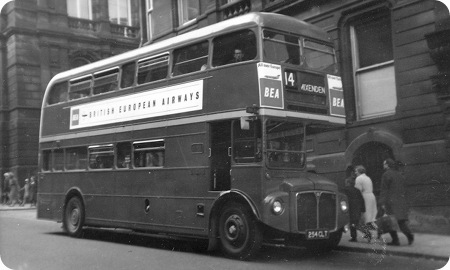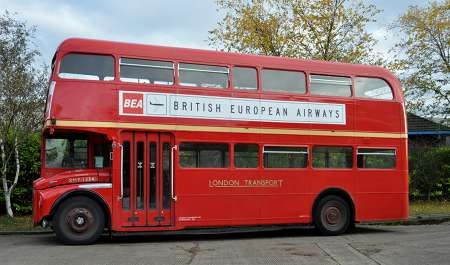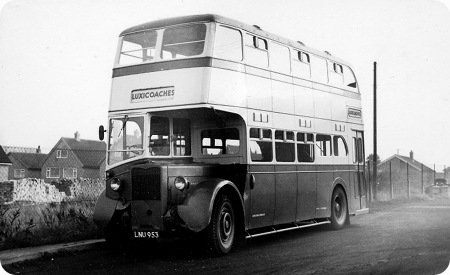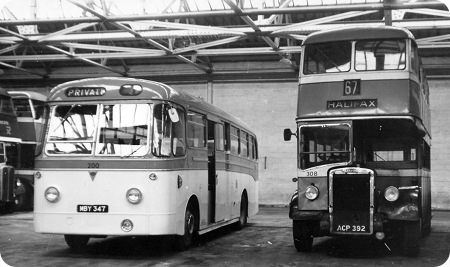London Transport – AEC Routemaster – 254 CLT – RMF 1254

Photograph by ‘unknown’ if you took this photo please go to the copyright page.
London Transport
1962
AEC-Park Royal Routemaster
Park Royal H38/31F
Whilst on loan to Halifax Corporation this was London Transports first front entrance Routemaster, it also had a tow bar fitted so it could tow a luggage trailer when doing airport duty. I think there was a connection with ‘British European Airways’ somehow but not over sure of exact detail If you know, let me know, please leave a comment.
There wasn’t many front entrance Routemasters compared to rear entrance even the Green Line coaches were rear entrance although they did have platform doors, nice seats and fluorescent lighting. The Routemaster really was built for town work having 9.6 or 11.3 litre AEC engines or a 9.8 litre Leyland Engine with a gearbox that gave the driver the choice of semi-automatic or fully automatic. Put all that power and the automatic gearbox together in a light chassis less body And you have a very nippy bus.
In one of my reference books on buses which I use for information I came across the following sentence.
”London introduced front entrance Routemasters (FRM) in 1967 with a rear mounted A.E.C 11.3 litre engines and Park Royal bodies seating 41 on the upper deck and 31 on the lower deck, and a laden weight of 13.55 tonnes.”
A Rear engined Routemaster! now that’s a new one on me can not find any photos on line or any information anywhere. The book was published by the Blandford Press so I would of thought the content would of been carefully checked. So all you Routemaster followers out there let me know if you know something about this mystery rear engined AEC, please leave a comment.
An interesting article regarding the front entrance Routemasters is here.
FRM1 (there was only 1 built) it is still around, it is part of the London Transport museum collection and I think it is kept at Acton. This link should reveal all! //www.countrybus.org/FRM/FRM.html
If that dose not work search for IAN’S BUS STOP and click on the FRM in the list of London bus classes. Hope that helps.
Michael
The rear engined Routemaster FRM 1 was unique, as was the above pictured RMF 1254. It was used by British European Airways prior to the purchase of their front entrance Routemasters.
In addition to Halifax, RMF 1254 was also loaned to Liverpool Corporation and East Kent, whilst in London Transport ownership.
It was fitted with a Leyland engine before being sold to Northern General in November 1966, where it lasted until October 1980 and is also now in preservation.
Pete Cook
RMF1254 was exhibited at the 1962 Earl’s Court Commercial Motor Show, and was later involved in service trials with BEA. It did indeed tow a luggage trailer whilst with them, and the experiment proved successful enough for BEA to place an order for 65 short forward entrance models. These too towed luggage trailers. They were powered by AEC AV690 engines developing 175bhp for use on the M4 motorway. RMF 1254 (Routemaster Forward entrance) was later sold to Northern General, where it joined their fleet of 50 similar vehicles. The rear engined Routemaster FRM1 (Front entrance Routemaster) used approximately 60% of standard Routemaster body parts. It had independent coil suspension at the front with air suspension at the rear. It was powered by an AEC AV691 11.3 litre engine developing 150bhp @ 1800rpm. A shame it was never allowed to enter production, as no doubt Northern General would have taken delivery of some. They were certainly impressed with the high standards set by the originals, which did not suffer the effects of corrosion encountered with their Atlanteans of a similar age.
Brendan Smith
With reference to London Transport’s tie-up with BEA, as an airline BEA didn’t want the overhead of operating passenger road vehicles and space to house them. So, while the vehicles were owned by BEA, they were operated by London Transport using LT drivers and were accommodated at the former Chiswick Tram Depot (later to become Stamford Brook bus garage). The service started initially with half-decker Commer Commandos; and continued into the early 1950s with a dedicated fleet of RFs (AEC Regal IVs with special Park Royal deck-and-a-half bodies).
Replacements were needed in the 1960s – larger aircraft now required larger vehicles. LT had conducted trials with double-deckers, one an AEC Regent V with a large rear luggage compartment and the other, RMF 1254, with a trailer.
The RMF trials having been successful, BEA ordered a fleet of 65, together with 88 luggage trailers (by Marshall). These RMAs differed from RMF1254 in various ways:
• They were of the standard Routemaster length, 27ft 8in.
• They had the standard engine but were geared for 70mph motorway operation.
• They were equipped with paraffin heaters to keep the interior warm during the sometimes lengthy waits at terminals.
• The destination displays were eliminated (as passengers knew where they were going)
• An illuminated panel above the front entrance advertised the airline, as did a matching panel on the offside.
• The drivers front window was of the single pane non-opening variety.
They went into service between the West London Air Terminal at Cromwell Road and Heathrow Airport from October 1966 after a brief trial period.
(Information adapted from Ian’s Bus Stop website.)
Trevor Haynes
25/09/11 – 18:02
When London Transport and Green line started to run down the Routemaster fleet they became scattered far and wide, but if I’m not mistaken Northern General were the only other operator who had Routemasters of any type from new. They were bought for the routes between Newcastle and Darlington, Hartlepool, Stockton and Middlesbrough. The Sunderland/Bishop Auckland route run by Sunderland & District (Northern General) used Burlingham bodied PD3’s fitted with rear doors.
Ronnie Hoye
08/10/14 – 06:58
I joined London Transport at 19 as a conductor on the trolleys at Stonebridge park garage, when we took over the Routemaster they were in a new world like a dream. I conducted then passed out as a driver, these buses were still in the experimental stages, some had Dunlopillow suspension that made the poor conductor feel sick. We had one that I reported for break problems RM1144 it frightened the life out of me one day, when I took it over the driver said watch the brakes, well as I was pulling up at a bus stop the brakes suddenly went off I put more pressure on the pedal and was thrown over the steering wheel, with a bit of practice I found if that if you left your foot where it was the brakes came back on. They were the most wonderful vehicle that was ever designed, we were told to drive our ones in auto all the time, Cricklewood were told to drive theirs in manual as it saved so many litres of fuel. As one of you comments about the sound of the engines, ours were AEC.
Brendan, you are right about the roar of that Leyland engine, wonderful a few more bits about the Routemaster, most of the Routemasters were governed at 44 mph, they were numbered in SLT, VLT, WLT, RM1000 was the odd one out with 100 BXL if I remember. I think it came from Brighton, then they went on to CLT and so on, some were fitted with moving advertising boards on the lower deck. I asked an instructor at Chiswick about taking one on the skidpan, and was told that at that time if it went into a skid it went into neutral gear but if it hit something it went back into gear, I was told on my test to pull up the dip in Chiswick put it in second gear and pull away, I found that was the only gear that it wont pull away in when the bus suddenly ran back down the slope. I have got great memories of my days on London Transport, my colleagues and the public, the old char ladies on the night bus from Edgware to London Bridge were great to chat to and we did not have much trouble at all.
Bix Curtis
17/11/14 – 08:36
Here is an updated picture of this vehicle. The preserved vehicle is seen at the LVVS running day.
Ken Jones
07/01/16 – 17:03
If you read this, Bix, I’d love to hear more recollections of RMs and also of trolleybuses. The trolleys must have been quite difficult to drive, especially when compared to a fully automatic RM.
Ernie Jupp
04/07/20 – 07:35
Short bodied RMs were designated 5RM5 and longer RMLs designated 7RM7. Does anyone know what the RMFs were designated. I believe the shorter BEA Routemasters were 9RM9, but what about RMF 1254 and the Northern vehicles?
Martyn H. Taylor



